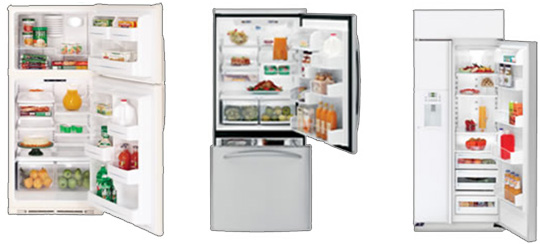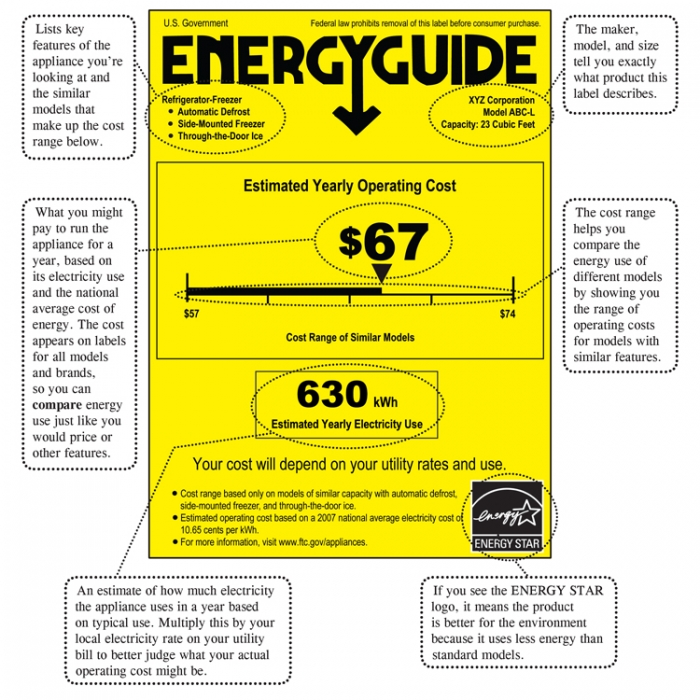5.4: Refrigerators
- Page ID
- 47180
\( \newcommand{\vecs}[1]{\overset { \scriptstyle \rightharpoonup} {\mathbf{#1}} } \)
\( \newcommand{\vecd}[1]{\overset{-\!-\!\rightharpoonup}{\vphantom{a}\smash {#1}}} \)
\( \newcommand{\id}{\mathrm{id}}\) \( \newcommand{\Span}{\mathrm{span}}\)
( \newcommand{\kernel}{\mathrm{null}\,}\) \( \newcommand{\range}{\mathrm{range}\,}\)
\( \newcommand{\RealPart}{\mathrm{Re}}\) \( \newcommand{\ImaginaryPart}{\mathrm{Im}}\)
\( \newcommand{\Argument}{\mathrm{Arg}}\) \( \newcommand{\norm}[1]{\| #1 \|}\)
\( \newcommand{\inner}[2]{\langle #1, #2 \rangle}\)
\( \newcommand{\Span}{\mathrm{span}}\)
\( \newcommand{\id}{\mathrm{id}}\)
\( \newcommand{\Span}{\mathrm{span}}\)
\( \newcommand{\kernel}{\mathrm{null}\,}\)
\( \newcommand{\range}{\mathrm{range}\,}\)
\( \newcommand{\RealPart}{\mathrm{Re}}\)
\( \newcommand{\ImaginaryPart}{\mathrm{Im}}\)
\( \newcommand{\Argument}{\mathrm{Arg}}\)
\( \newcommand{\norm}[1]{\| #1 \|}\)
\( \newcommand{\inner}[2]{\langle #1, #2 \rangle}\)
\( \newcommand{\Span}{\mathrm{span}}\) \( \newcommand{\AA}{\unicode[.8,0]{x212B}}\)
\( \newcommand{\vectorA}[1]{\vec{#1}} % arrow\)
\( \newcommand{\vectorAt}[1]{\vec{\text{#1}}} % arrow\)
\( \newcommand{\vectorB}[1]{\overset { \scriptstyle \rightharpoonup} {\mathbf{#1}} } \)
\( \newcommand{\vectorC}[1]{\textbf{#1}} \)
\( \newcommand{\vectorD}[1]{\overrightarrow{#1}} \)
\( \newcommand{\vectorDt}[1]{\overrightarrow{\text{#1}}} \)
\( \newcommand{\vectE}[1]{\overset{-\!-\!\rightharpoonup}{\vphantom{a}\smash{\mathbf {#1}}}} \)
\( \newcommand{\vecs}[1]{\overset { \scriptstyle \rightharpoonup} {\mathbf{#1}} } \)
\( \newcommand{\vecd}[1]{\overset{-\!-\!\rightharpoonup}{\vphantom{a}\smash {#1}}} \)
\(\newcommand{\avec}{\mathbf a}\) \(\newcommand{\bvec}{\mathbf b}\) \(\newcommand{\cvec}{\mathbf c}\) \(\newcommand{\dvec}{\mathbf d}\) \(\newcommand{\dtil}{\widetilde{\mathbf d}}\) \(\newcommand{\evec}{\mathbf e}\) \(\newcommand{\fvec}{\mathbf f}\) \(\newcommand{\nvec}{\mathbf n}\) \(\newcommand{\pvec}{\mathbf p}\) \(\newcommand{\qvec}{\mathbf q}\) \(\newcommand{\svec}{\mathbf s}\) \(\newcommand{\tvec}{\mathbf t}\) \(\newcommand{\uvec}{\mathbf u}\) \(\newcommand{\vvec}{\mathbf v}\) \(\newcommand{\wvec}{\mathbf w}\) \(\newcommand{\xvec}{\mathbf x}\) \(\newcommand{\yvec}{\mathbf y}\) \(\newcommand{\zvec}{\mathbf z}\) \(\newcommand{\rvec}{\mathbf r}\) \(\newcommand{\mvec}{\mathbf m}\) \(\newcommand{\zerovec}{\mathbf 0}\) \(\newcommand{\onevec}{\mathbf 1}\) \(\newcommand{\real}{\mathbb R}\) \(\newcommand{\twovec}[2]{\left[\begin{array}{r}#1 \\ #2 \end{array}\right]}\) \(\newcommand{\ctwovec}[2]{\left[\begin{array}{c}#1 \\ #2 \end{array}\right]}\) \(\newcommand{\threevec}[3]{\left[\begin{array}{r}#1 \\ #2 \\ #3 \end{array}\right]}\) \(\newcommand{\cthreevec}[3]{\left[\begin{array}{c}#1 \\ #2 \\ #3 \end{array}\right]}\) \(\newcommand{\fourvec}[4]{\left[\begin{array}{r}#1 \\ #2 \\ #3 \\ #4 \end{array}\right]}\) \(\newcommand{\cfourvec}[4]{\left[\begin{array}{c}#1 \\ #2 \\ #3 \\ #4 \end{array}\right]}\) \(\newcommand{\fivevec}[5]{\left[\begin{array}{r}#1 \\ #2 \\ #3 \\ #4 \\ #5 \\ \end{array}\right]}\) \(\newcommand{\cfivevec}[5]{\left[\begin{array}{c}#1 \\ #2 \\ #3 \\ #4 \\ #5 \\ \end{array}\right]}\) \(\newcommand{\mattwo}[4]{\left[\begin{array}{rr}#1 \amp #2 \\ #3 \amp #4 \\ \end{array}\right]}\) \(\newcommand{\laspan}[1]{\text{Span}\{#1\}}\) \(\newcommand{\bcal}{\cal B}\) \(\newcommand{\ccal}{\cal C}\) \(\newcommand{\scal}{\cal S}\) \(\newcommand{\wcal}{\cal W}\) \(\newcommand{\ecal}{\cal E}\) \(\newcommand{\coords}[2]{\left\{#1\right\}_{#2}}\) \(\newcommand{\gray}[1]{\color{gray}{#1}}\) \(\newcommand{\lgray}[1]{\color{lightgray}{#1}}\) \(\newcommand{\rank}{\operatorname{rank}}\) \(\newcommand{\row}{\text{Row}}\) \(\newcommand{\col}{\text{Col}}\) \(\renewcommand{\row}{\text{Row}}\) \(\newcommand{\nul}{\text{Nul}}\) \(\newcommand{\var}{\text{Var}}\) \(\newcommand{\corr}{\text{corr}}\) \(\newcommand{\len}[1]{\left|#1\right|}\) \(\newcommand{\bbar}{\overline{\bvec}}\) \(\newcommand{\bhat}{\widehat{\bvec}}\) \(\newcommand{\bperp}{\bvec^\perp}\) \(\newcommand{\xhat}{\widehat{\xvec}}\) \(\newcommand{\vhat}{\widehat{\vvec}}\) \(\newcommand{\uhat}{\widehat{\uvec}}\) \(\newcommand{\what}{\widehat{\wvec}}\) \(\newcommand{\Sighat}{\widehat{\Sigma}}\) \(\newcommand{\lt}{<}\) \(\newcommand{\gt}{>}\) \(\newcommand{\amp}{&}\) \(\definecolor{fillinmathshade}{gray}{0.9}\)Refrigerators are heat movers, which move heat from a low temperature (inside the refrigerator) to high temperature (outside the refrigerator into the kitchen). Heat movers do not produce any heat but just move from one location to another.
The following video shows how a heat mover works.
How Does a Refrigerator Work?
The principle of operation of a refrigerator is similar to an air conditioner. It moves the heat energy from inside to outside. There are four basic components in a refrigerator and their functions are as follows:
- Expansion valve - A liquid refrigerant at high pressure flows through an expansion valve. As the refrigerant moves through the expansion valve, it moves from a high-pressure zone to a low-pressure zone. The decrease in pressure corresponds with a decrease in temperature.
- Evaporator or heat exchanging pipes - A set of coiled tubes carrying the low pressure, expanded refrigerant. In the evaporator, the liquid refrigerant also expands and evaporates. The evaporation of liquid takes away heat, creating cold gas in the coils. The cold refrigerant flowing through the coils absorbs heat from the refrigerator. The food gets cold. However, the refrigerant warms up because of the absorption of heat.
- Compressor - A device that pressurizes the warm refrigerant and makes it hot (hotter than the kitchen temperature). This hot refrigerant goes into the condenser.
- Condenser or second heat exchanger coil - Located at the back of the refrigerator where it gives off the heat to the air in the kitchen.
The following video explains how a refrigerator works.
Types and Features
There are four types of refrigerators: top-freezer (or top-mount), bottom-freezer (or bottom-mount), side-by-side, and built-in (as shown in Figure 5.4.1).
Refrigerators also come in four size categories: small (7 to 9.9 cubic feet), medium (10 to 13.9 cubic feet), large (14 to 19.9 cubic feet), and extra large (20 to 29 cubic feet).

Figure 5.4.1. Types of refrigerators: top mounted (left), bottom mounted (middle), side-by-side (right)
Energy Efficiency of a Refrigerator
Most of the energy used by a refrigerator is used to pump heat out of the cabinet. A small amount is used to keep the cabinet from sweating, to defrost the refrigerator, and to illuminate the interior.
The efficiency of a refrigerator is based on the energy consumed per year for a given size. The efficiency of a refrigerator is expressed in volume cooled per unit electric energy per day, i.e.,
\[ Refrigerator \, Efficiency = \dfrac{Volume \, Cooled \, (ft^3)}{Unit \, Electrical \, Energy \, per \, day \, (kWh)} \]
The energy efficiency of refrigerators and freezers has improved dramatically over the past three decades. For example, the energy bill for a typical new refrigerator with automatic defrost and top-mounted freezer will be about $55 per year, whereas a typical model sold in 1973 will cost nearly $160 per year (almost three times the energy consumption).
The Department of Energy (DOE) standards set maximum allowable annual energy consumption for different sizes and classes of refrigerators. These Federal efficiency standards first took effect in 1993, requiring new refrigerators and freezers to be more efficient than ever before. A new set of stricter standards took effect July 1, 2001.
EnergyGuide Labels
Refrigerators now come with an EnergyGuide label, shown in Figure 5.4.2, that tells you in kilowatt-hours (kWh) how much electricity a particular model uses in a year. The smaller the number, the less energy the refrigerator uses and the less it will cost you to operate.
- Full-sized refrigerators that exceed the federal standard by 15% or more (and full-sized freezers that exceed it by 10%) qualify for the ENERGY STAR label.
- Compact refrigerators and freezers must exceed the standard by 20% to qualify for ENERGY STAR.

Figure 5.4.2. EnergyGuide label
ENERGY STAR qualified refrigerators provide energy savings without sacrificing the features you want. ENERGY STAR–qualified models have
- High-efficiency compressors
- Improved insulation
- More precise temperature
- More precise defrost mechanisms
These models also use at least 15% less energy than required by current federal standards, and 40% less energy than the conventional models sold in 2001.
Many ENERGY STAR qualified models include automatic ice-maker and through-the-door ice dispensers. Qualified models are also available with top, bottom, and side-by-side freezers.
What to Look for in a Refrigerator
When selecting a refrigerator, remember the following:
- Refrigerators with the freezer on either the bottom or top are the most efficient. Bottom freezer models use approximately 16 percent less energy than side-by-side models and top freezer models use about 13 percent less than side-by-side.
- Through-the-door ice makers and water dispensers are convenient and reduce the need to open the door, which helps maintain a more constant temperature; however, these convenient items will increase your refrigerator's energy use by 14 to 20 percent.
- Mini-doors give you easy access to items most often used. The main door is opened less often, which saves energy.
- Too large a refrigerator may waste space and energy. One that's too small can mean extra trips to the grocery store. Your best bet is to decide which size fits your needs, and then compare the EnergyGuide label on each so you can purchase the most energy efficient make and model.
- A manual defrost refrigerator uses half the energy of an automatic defrost model but must be defrosted regularly to stay energy efficient.
- Refrigerators with anti-sweat heaters consume 5 percent to 10 percent more energy. Look for models with an "energy saver" switch that lets you turn down—or off—the heating coils (which prevent condensation).
Technology Requirements
The improvement in the energy efficiency over the past three decades is due to the:
- addition of vacuum insulation panels around the freezer section to reduce heat transfer;
- addition of polyurethane foam to the doors to double insulation thickness;
- replacement of AC motors with more efficient DC motors;
- replacement of automatic defrost control with an adaptive defrost that operates only when needed.
Refrigerators and Environmental Protection
Here are some things you can control to minimize the environmental impact of your refrigerator.
- Keep your refrigerator or freezer at the following temperatures: 37–40°F for the fresh food compartment of the refrigerator, 0–5°F for the freezer section. Use a thermometer to check inside temperatures.
- Regularly defrost manual-defrost refrigerators and freezers; don't allow frost to build up more than 1/4 inch.
- Make sure your refrigerator and freezer door seals are airtight. Check the seal on door gaskets periodically by closing the door on a dollar bill. If it pulls out easily, you may need a new gasket.
- Keep the doors closed as much as possible and make sure they are closed tightly.
- To ensure proper cooling of its contents, don't crowd food items. Too many dishes obstruct air circulation.
- Cover liquids and wrap foods stored in the refrigerator. Uncovered foods release moisture and make the compressor work harder.
- Replace paper wrappings on food items with aluminum foil or plastic wrap. Paper is an insulator.
- Consider turning off the butter conditioner since it is a little heater inside your refrigerator.
- Experiment with the "energy saver" switch in your refrigerator—it allows you to adjust the heating coil under the "skin" of the refrigerator (the purpose of the heating coils is to prevent condensation on your refrigerator).
- Placement of the refrigerator is very important. Direct sunlight and close contact with hot appliances will make the compressor work harder. More importantly, heat from the compressor and condensing coil must be able to escape freely, or it will cause the same problem. Don't suffocate the refrigerator by enclosing it tightly in cabinets or against the wall. The proper breathing space will vary depending on the location of the coils and compressor on each model—something important to know before the cabinets are redesigned.
- Regularly brush off or vacuum the refrigerator coils on the back or bottom of the unit.
- Because most refrigerators reject heat from the bottom and/or back, they need adequate clearance to allow sufficient airflow. While no specific studies have been done to calculate the optimum clearance space, one general rule-of-thumb is to double the space recommended by manufacturers for refrigerator installation. Another rule-of-thumb is to allow 2 inches of air flow around the refrigerator.
- Don't keep that old, inefficient fridge running day and night in the garage for those few occasions when you need extra refreshments. A 15-year-old refrigerator could cost $100 to $150 per year.


